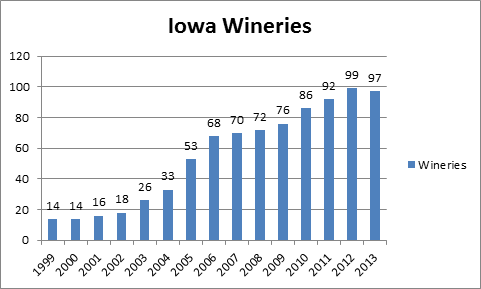by Michael L. White, ISU Extension Viticulture Specialist
I still remember that cold day on Saturday, February 19, 2000. We had a heavy snow the night before. Around 125 people from all around the state of Iowa showed up to a winegrape growing workshop held at the Odd Fellows Hall in Indianola, Iowa. The enthusiasm was sky high and everyone left at the end of the day with their marching orders. Grow grapes, make wine and have fun.
It was not a hard sell. Many of the people who came to this first winegrape workshop were the pioneers who established the winegrape industry we have today. Many have vineyards and/or wineries operating today. Many have fallen to the wayside. What sounded good ended up being too management, labor and capital intensive for their lifestyle.
In February of 2000 Iowa had 13 wineries of which only two had vineyards and making grape wine. There were only hand full of commercial winegrape vineyards in the state covering less than 30 acres. We ended 2013 with 97 operating wineries and 316+ vineyards covering 1,200+ acres. The Iowa Alcohol Beverages Division reported 263,682 gallons of Iowa produced wine was sold during 2013. Iowa wineries now have 5.92% of the retail wine market share in Iowa compared to less than 1% market share we had in 2000. A 5.92% market share may seem low until you consider that California (58%) and foreign imports (32%) take approximately 90% of the remaining market share in the U.S.
As you can see from the chart above, the Iowa wine industry is starting to mature. Some of the people who were in their 50’s and 60’s when they jumped into this business are no longer in the business. New vineyards and wineries still appear each year, just not as many as in the early years. Many of the older enterprises are expanding. New entrepreneurs entering this industry have more access to knowledge, resources and services than the early pioneers had available. The early days of the blind leading the blind are now over. The wineries and vineyards of today are moving from a lifestyle model to more of a business model. They are looking at new products, services and amenities that they can market to make money, spread their risk and hire employees.
More Iowa wineries will be offering a larger variety of wines. We will see more fortified and sparkling wines. We will also see more fruit and honey wines and hard ciders popping up on the counter. More unique blends and new varietal wines will appear. Quality will increase as our overall wine making experience increases. Everyone knows that wine is the seed to many more economic activities. We will see more wineries expand into more or larger event facilities, bed-n-breakfasts, gift shops, restaurants and offer greater range of entertainment activities.
The future of the Iowa native wine industry still looks good. Our culture is changing. Beer is no longer king. There is a place for native wine in Iowa’s future. I predict a slow and steady growth that will strengthen our industry over time. Slow and steady is more sustainable than the fast and wild days of the recent past.
XXXXXX
Michael L. White CCA, CPAg, CSW
Viticulture Specialist
ISU University Extension & Outreach
909 East 2nd Ave, Suite E
Indianola, IA 50125-2892
Office: 515-961-6237, Fax: 6017
Cell: 515-681-7286
E-mail: mlwhite@iastate.edu
Midwest Grape and Wine Industry Institute
